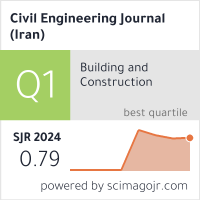An Automated Assessment Technique for Pavement Defects Using a Laser Scanner and Deep Machine Learning
Downloads
Doi:10.28991/CEJ-2025-011-03-015
Full Text:PDF
Downloads
[2] Al-Suleiman, T. I., Obaidat, M. T., Abdul-Jabbar, G. T., & Khedaywi, T. S. (2000). Field inspection and laboratory testing of highway pavement rutting. Canadian Journal of Civil Engineering, 27(6), 1109–1119. doi:10.1139/l00-037.
[3] Shahin, M. Y. (1994). Pavement Management for Airports, Roads, and Parking Lots. Springer, New York, United States. doi:10.1007/978-1-4757-2287-1.
[4] Oliveira, H. J. M. (2013). Crack detection and characterization in flexible road pavements using digital image processing. Instituto Superior Tecnico, Lisbon, Portugal.
[5] Meignen, D., Bernadet, M., & Briand, H. (1997). One application of neural networks for detection of defects using video data bases: identification of road distresses. Database and Expert Systems Applications. 8th International Conference, DEXA '97. Proceedings, 459–464. doi:10.1109/dexa.1997.617332.
[6] Cheng, H. D., & Miyojim, M. (1998). Automatic pavement distress detection system. Information Sciences, 108(1–4), 219–240. doi:10.1016/S0020-0255(97)10062-7.
[7] Subirats, P., Fabre, O., Dumoulin, J., Legeay, V., & Barba, D. (2004). A combined wavelet-based image processing method for emergent crack detection on pavement surface images. 2004 12th European signal processing conference, 6-10 September, 2004, Vienna, Austria.
[8] Beraldin, J. A., Blais, F., & Lohr, U. (2010). Laser Scanning Technology. Airborne and Terrestrial Laser Scanning, Whittles Publishing, London, United Kingdom.
[9] Wang, K. C. P. (2000). Designs and Implementations of Automated Systems for Pavement Surface Distress Survey. Journal of Infrastructure Systems, 6(1), 24–32. doi:10.1061/(asce)1076-0342(2000)6:1(24).
[10] Zhang, W., Zhang, Z., Qi, D., & Liu, Y. (2014). Automatic crack detection and classification method for subway tunnel safety monitoring. Sensors (Switzerland), 14(10), 19307–19328. doi:10.3390/s141019307.
[11] Zhang, L., Yang, F., Daniel Zhang, Y., & Zhu, Y. J. (2016). Road crack detection using deep convolutional neural network. 2016 IEEE International Conference on Image Processing (ICIP), 3708–3712. doi:10.1109/icip.2016.7533052.
[12] Shatnawi, N. (2018). Automatic pavement cracks detection using image processing techniques and neural network. International Journal of Advanced Computer Science and Applications, 9(9), 399–402. doi:10.14569/ijacsa.2018.090950.
[13] Hoffmeister, D. (2020). Geological Records of Tsunamis and Other Extreme Waves. Elsevier, Amsterdam, Netherlands. doi:10.1016/c2017-0-03458-4
[14] Shan, J., & Toth, C. K. (2017). Topographic Laser Ranging and Scanning. CRC Press, Boca Raton, United States. doi:10.1201/9781420051438.
[15] Dickmanns, E. D., & Mysliwetz, B. D. (1992). Recursive 3-D Road and Relative Ego-State Recognition. IEEE Transactions on Pattern Analysis and Machine Intelligence, 14(2), 199–213. doi:10.1109/34.121789.
[16] Tao, C. V., & Li, J. (2007). Advances in Mobile Mapping Technology. CRC Press, London, United Kingdom. doi:10.4324/9780203961872.
[17] Al-Durgham, K., Lichti, D. D., Kwak, E., & Dixon, R. (2021). Automated accuracy assessment of a mobile mapping system with lightweight laser scanning and mems sensors. Applied Sciences (Switzerland), 11(3), 1–14. doi:10.3390/app11031007.
[18] Haala, N., Peter, M., Cefalu, A., & Kremer, J. (2008). Mobile LIDAR mapping for urban data capture. Proceedings of the 14th International Conference on Virtual Systems and Multimedia, 20-25 October, 2008, Limassol, Cyprus.
[19] Tsai, Y., Ai, C., Wang, Z., & Pitts, E. (2013). Mobile cross-slope measurement method using LIDAR technology. Transportation Research Record, 2367(2367), 53–59. doi:10.3141/2367-06.
[20] Campbell, D. M. H., White, B., & Arp, P. A. (2013). Modeling and mapping Soil resistance to penetration and rutting using LiDAR-derived digital elevation data. Journal of Soil and Water Conservation, 68(6), 460–473. doi:10.2489/jswc.68.6.460.
[21] Obaidat, M. T., Shatnawi, N., & Al-Sharideah, A. (2021). Geomatics techniques for evaluation of road pavement rutting. Applied Geomatics, 13(2), 217–225. doi:10.1007/s12518-020-00337-0.
[22] Hu, Y., Zhao, C., & Wang, H. (2010). Automatic Pavement Crack Detection Using Texture and Shape Descriptors. IETE Technical Review, 27(5), 398. doi:10.4103/0256-4602.62225.
[23] Cord, A., & Chambon, S. (2012). Automatic Road Defect Detection by Textural Pattern Recognition Based on AdaBoost. Computer-Aided Civil and Infrastructure Engineering, 27(4), 244–259. doi:10.1111/j.1467-8667.2011.00736.x.
[24] Shi, Y., Cui, L., Qi, Z., Meng, F., & Chen, Z. (2016). Automatic road crack detection using random structured forests. IEEE Transactions on Intelligent Transportation Systems, 17(12), 3434–3445. doi:10.1109/TITS.2016.2552248.
[25] Liu, F., Liu, J., & Wang, L. (2022). Deep learning and infrared thermography for asphalt pavement crack severity classification. Automation in Construction, 140, 104383. doi:10.1016/j.autcon.2022.104383.
[26] Shtayat, A., Moridpour, S., Best, B., & Abuhassan, M. (2023). Using supervised machine learning algorithms in pavement degradation monitoring. International Journal of Transportation Science and Technology, 12(2), 628–639. doi:10.1016/j.ijtst.2022.10.001.
[27] Kim, E., Jang, W. J., Kim, W., Park, J., Lee, M. K., Park, S. H. K., & Choi, K. C. (2016). Suppressed Instability of a-IGZO Thin-Film Transistors Under Negative Bias Illumination Stress Using the Distributed Bragg Reflectors. IEEE Transactions on Electron Devices, 63(3), 1066–1071. doi:10.1109/TED.2015.2513414.
[28] Sun, L., Kamaliardakani, M., & Zhang, Y. (2016). Weighted Neighborhood Pixels Segmentation Method for Automated Detection of Cracks on Pavement Surface Images. Journal of Computing in Civil Engineering, 30(2), 1–11. doi:10.1061/(asce)cp.1943-5487.0000488.
[29] Akagic, A., Buza, E., Omanovic, S., & Karabegovic, A. (2018). Pavement crack detection using Otsu thresholding for image segmentation. 2018 41st international convention on information and communication technology, electronics and microelectronics (MIPRO), 21-25 May, 2018, Opatija, Croatia.
[30] Sari, Y., & Prakoso, P. B. (2018). Detection of Moving Vehicle using Adaptive Threshold Algorithm in Varied Lighting. 2018 5th International Conference on Electric Vehicular Technology (ICEVT), 136–141. doi:10.1109/icevt.2018.8628398.
[31] Prakoso, P. B., & Sari, Y. (2019). Vehicle detection using background subtraction and clustering algorithms. Telkomnika (Telecommunication Computing Electronics and Control), 17(3), 1393–1398. doi:10.12928/TELKOMNIKA.V17I3.10144.
[32] Prasanna, P., Dana, K., Gucunski, N., & Basily, B. (2012). Computer-vision based crack detection and analysis. Sensors and Smart Structures Technologies for Civil, Mechanical, and Aerospace Systems 2012. doi:10.1117/12.915384.
[33] Hoang, N. D., & Nguyen, Q. L. (2019). A novel method for asphalt pavement crack classification based on image processing and machine learning. Engineering with Computers, 35(2), 487–498. doi:10.1007/s00366-018-0611-9.
[34] Gavilán, M., Balcones, D., Marcos, O., Llorca, D. F., Sotelo, M. A., Parra, I., Ocaña, M., Aliseda, P., Yarza, P., & Amírola, A. (2011). Adaptive road crack detection system by pavement classification. Sensors, 11(10), 9628–9657. doi:10.3390/s111009628.
[35] Chen, X., Yongchareon, S., & Knoche, M. (2023). A review on computer vision and machine learning techniques for automated road surface defect and distress detection. Journal of Smart Cities and Society, 1(4), 259–275. doi:10.3233/scs-230001.
[36] Finogeev, A., Deev, M., Finogeev, A., & Parygin, D. (2024). Recognition and Clustering of Road Pavement Defects by Deep Machine Learning Methods. Machine Learning Methods in Systems, CSOC 2024, Lecture Notes in Networks and Systems, 1126, Springer, Cham, Switzerland. doi:10.1007/978-3-031-70595-3_48.
[37] Hassan, S., O'sullivan, D., Mckeever, S., Power, D., Mcgowan, R., & Feighan, K. (2022). Detecting Patches on Road Pavement Images Acquired with 3D Laser Sensors using Object Detection and Deep Learning. Proceedings of the 17th International Joint Conference on Computer Vision, Imaging and Computer Graphics Theory and Applications. doi:10.5220/0010830000003124.
[38] Mihoub, A., Krichen, M., Alswailim, M., Mahfoudhi, S., & Bel Hadj Salah, R. (2023). Road Scanner: A Road State Scanning Approach Based on Machine Learning Techniques. Applied Sciences (Switzerland), 13(2). doi:10.3390/app13020683.
[39] Cui, P., Bidzikrillah, N. A., Xu, J., & Qin, Y. (2024). Application of the Semi-Supervised Learning Approach for Pavement Defect Detection. Sensors, 24(18). doi:10.3390/s24186130.
[40] Daneshvari, M. H., Mojaradi, B., Ameri, M., & Nourmohammadi, E. (2024). Automation detection of asphalt pavement bleeding for imbalanced datasets using an anomaly detection approach. Measurement: Journal of the International Measurement Confederation, 235, 114987. doi:10.1016/j.measurement.2024.114987.
[41] Han, C., Yang, H., Ma, T., Wang, S., Zhao, C., & Yang, Y. (2024). Crack Diffusion: A two-stage semantic segmentation framework for pavement crack combining unsupervised and supervised processes. Automation in Construction, 160, 105332. doi:10.1016/j.autcon.2024.105332.
[42] Isradi, M., Rifai, A. I., Prasetijo, J., Kinasih, R. K., & Setiawan, M. I. (2024). Development of Pavement Deterioration Models Using Markov Chain Process. Civil Engineering Journal (Iran), 10(9), 2954–2965. doi:10.28991/CEJ-2024-010-09-012.
[43] Zafar, M. S., Shah, S. N. R., Memon, M. J., Rind, T. A., & Soomro, M. A. (2019). Condition Survey for Evaluation of Pavement Condition Index of a Highway. Civil Engineering Journal (Iran), 5(6), 1367–1383. doi:10.28991/cej-2019-03091338.
[44] Daneshvari, M. H., Mojaradi, B., Ameri, M., & Nourmohammadi, E. (2024). Hybrid texture analysis of 2D images for detecting asphalt pavement bleeding and raveling using tree-based ensemble methods. Alexandria Engineering Journal, 107, 150-164. doi:10.1016/j.aej.2024.07.028.
[45] Zhang, D., Zou, Q., Lin, H., Xu, X., He, L., Gui, R., & Li, Q. (2018). Automatic pavement defect detection using 3D laser profiling technology. Automation in Construction, 96, 350–365. doi:10.1016/j.autcon.2018.09.019.
[46] Chow, J. C. (2014). Multi-sensor integration for indoor 3D reconstruction. Doctoral dissertation, University of Calgary, Calgary, Canada.
[47] Azam, A., Alshehri, A. H., Alharthai, M., El-Banna, M. M., Yosri, A. M., & Beshr, A. A. A. (2023). Applications of Terrestrial Laser Scanner in Detecting Pavement Surface Defects. Processes, 11(5), 1370. doi:10.3390/pr11051370.
[48] Zheng, L., Xiao, J., Wang, Y., Wu, W., Chen, Z., Yuan, D., & Jiang, W. (2024). Deep learning-based intelligent detection of pavement distress. Automation in Construction, 168. doi:10.1016/j.autcon.2024.105772.
[49] Riid, A., Líµuk, R., Pihlak, R., Tepljakov, A., & Vassiljeva, K. (2019). Pavement distress detection with deep learning using the orthoframes acquired by a mobile mapping system. Applied Sciences (Switzerland), 9(22), 4829. doi:10.3390/app9224829.
[50] Shahin, M. Y., & Walther, J. a. (1990). Pavement Maintenance Management for Roads and Streets Using the PAVER System No. CERL-TR-M-90/05. US Army Corps of Engineers, Construction Engineering Research Laboratory, Washington, United States.
[51] Gopalakrishnan, K., Khaitan, S. K., Choudhary, A., & Agrawal, A. (2017). Deep Convolutional Neural Networks with transfer learning for computer vision-based data-driven pavement distress detection. Construction and Building Materials, 157, 322–330. doi:10.1016/j.conbuildmat.2017.09.110.
[52] Rajadurai, R. S., & Kang, S. T. (2021). Automated vision-based crack detection on concrete surfaces using deep learning. Applied Sciences (Switzerland), 11(11), 5229. doi:10.3390/app11115229.
[53] Stricker, R., Eisenbach, M., Sesselmann, M., Debes, K., & Gross, H.-M. (2019). Improving Visual Road Condition Assessment by Extensive Experiments on the Extended GAPs Dataset. 2019 International Joint Conference on Neural Networks (IJCNN), 1–8. doi:10.1109/ijcnn.2019.8852257.
[54] Chaiyasarn, K. (2014). Damage detection and monitoring for tunnel inspection based on computer vision. Ph.D. Thesis, University of Cambridge, Cambridge, United Kingdom.
- Authors retain all copyrights. It is noticeable that authors will not be forced to sign any copyright transfer agreements.
- This work (including HTML and PDF Files) is licensed under a Creative Commons Attribution 4.0 International License.![]()















